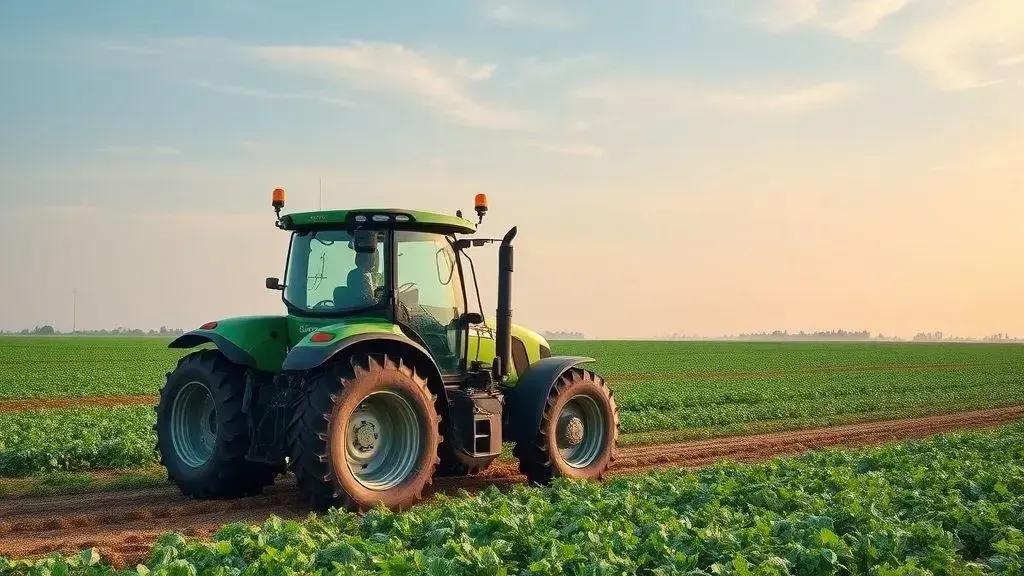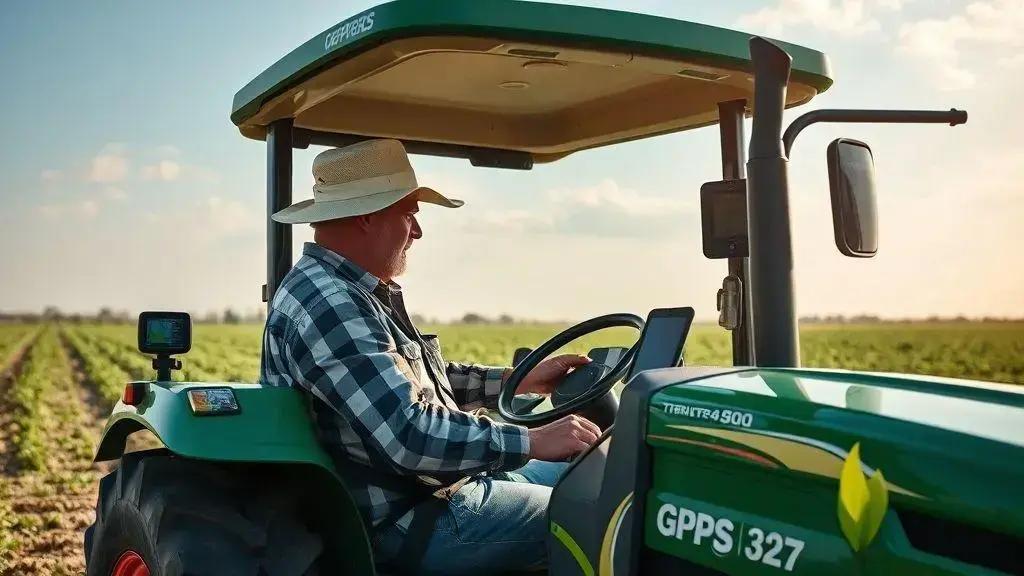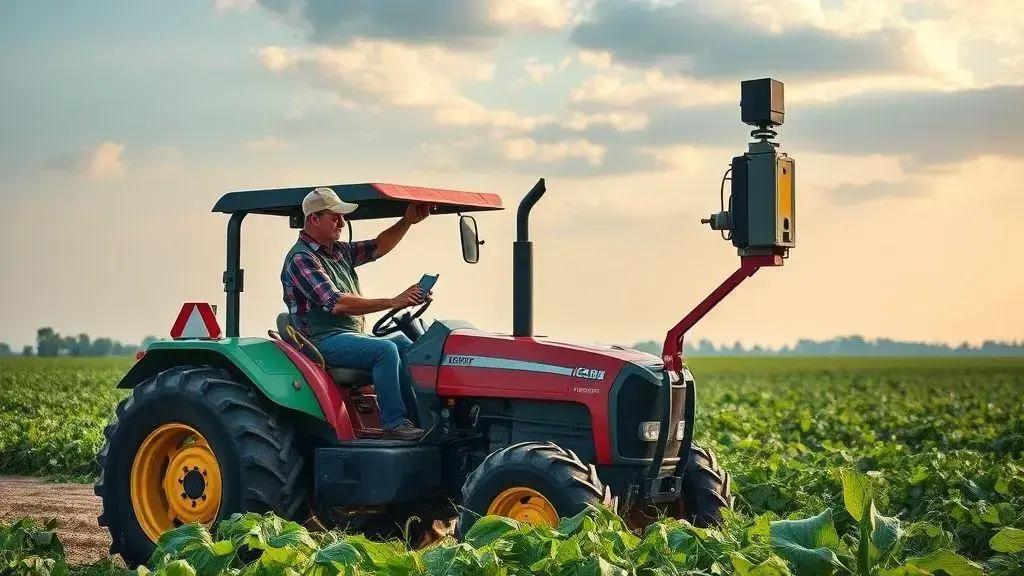GPS-guided tractor steering technology for smarter farming

GPS-guided tractor steering technology enhances farming by providing precise navigation, improving operational efficiency, reducing costs, and enabling better data collection for informed decision-making.
GPS-guided tractor steering technology is changing the way farmers operate their machinery. Imagine being able to steer your tractor with pinpoint accuracy, saving time and resources. Curious how this works? Let’s dive into the details.
Understanding GPS-guided tractor steering technology
Understanding GPS-guided tractor steering technology is essential for modern farming. This technology allows tractors to navigate fields with remarkable accuracy, making them more efficient and effective. But how does it really work?
The Basics of GPS Technology
GPS, or Global Positioning System, relies on satellites to provide location data. When farmers use GPS in tractors, they can achieve precise positioning, which is key for tasks like planting and harvesting. This technology integrates with steering systems to automate vehicle control based on GPS signals.
Key Components of GPS-guided Steering Systems
Various components make up a GPS-guided steering system:
- GPS Receiver: Captures signals from satellites.
- Steering Controller: Adjusts the tractor’s steering based on GPS data.
- Display Unit: Shows real-time information to the operator.
- Subscription Services: Provide access to enhanced GPS signals for better accuracy.
The combination of these components allows farmers to conduct field operations with high precision. For instance, when planting seeds, a GPS-guided system ensures that seeds are placed at the optimal distance apart, promoting growth and maximizing yields.
Benefits of Using GPS-guided Technology
Implementing GPS-guided tractor steering technology comes with numerous advantages:
- Increased efficiency in planting and harvesting.
- Reduction in fuel costs through optimized routes.
- Less overlap, leading to savings on seeds and fertilizers.
- Enhanced data collection for future farming decisions.
With these benefits, it’s clear why many farmers are eager to adopt GPS-guided systems. As they become more common, the advantages of efficiency and sustainability in agriculture will become even more pronounced. This technology not only supports growth but also paves the way for smarter farming practices that can adapt to future challenges.
Benefits of using GPS technology for tractors

Using GPS technology for tractors offers several key benefits that enhance farming efficiency. These advantages are driving many farmers to adopt this innovative approach.
Improved Efficiency
GPS technology allows tractors to drive straight lines, reducing the likelihood of overlapping in fields. This precise navigation translates into less wasted time and resources. Farmers can cover more ground faster while minimizing human errors that can lead to inefficiencies.
Cost Savings
Implementing GPS-guided systems can lead to significant cost savings over time. The precision of GPS minimizes waste, which includes:
- Fuel Costs: Less overlapping means reduced fuel consumption.
- Seed and Fertilizer Usage: Accurate planting reduces over-seeding and excess fertilizer application.
- Maintenance Costs: Efficient operation leads to less wear and tear on equipment.
As a result, many farmers see a noticeable decrease in their operational costs.
Enhanced Data Collection
Another crucial benefit is the ability to gather data as the tractor operates. GPS technology allows farmers to monitor their fields more closely. They can collect information about crop yields, soil conditions, and more. This data is invaluable for making informed decisions in the future.
Farmers can use this information to adjust planting techniques, manage resources better, and improve their overall yields. For instance, knowing which areas of a field consistently underperform can guide targeted interventions, maximizing productivity.
Sustainability
By adopting GPS-guided systems, farmers contribute to more sustainable agricultural practices. Reducing the use of chemicals and optimizing land usage is beneficial for the environment. The ability to work efficiently with precision translates to less impact on natural resources.
The future of farming lies in technology, and GPS technology for tractors is at the forefront, empowering farmers to operate smarter and more sustainably. As adoption grows, these benefits will continue to shape the industry.
How to implement GPS steering in your farming
Implementing GPS steering technology in your farming operations can seem daunting, but it’s quite manageable. With a few steps, you can enhance your efficiency and overall productivity.
Choose the Right Equipment
The first step is selecting the appropriate machinery and GPS equipment. New tractors often come equipped with GPS systems. If you have existing equipment, you can retrofit it with GPS technology. Consider factors such as:
- Compatibility: Ensure the GPS system works with your tractor model.
- Accuracy: Look for systems with high accuracy, ideally within a few centimeters.
- User-friendly Interfaces: Choose a system that is easy to operate and understand.
By focusing on these aspects, you set yourself up for a successful implementation.
Training and Familiarization
Once you have the equipment, it’s crucial to train yourself and your team. Understanding how to operate the GPS system effectively allows you to maximize its potential. Consider the following:
- Hands-on Training: Spend time practicing with the equipment in a safe environment.
- Online Resources: Many manufacturers offer guides and videos for training.
- Workshops: Attend workshops or training sessions offered by local agricultural institutions.
This preparation will boost confidence and ensure efficient operation on the field.
Testing and Adjustments
After training, it’s time to test the system in the field. Start with small areas to see how well the GPS performs. Pay attention to its accuracy and make necessary adjustments. Remember, fine-tuning settings can enhance its performance significantly.
During testing, monitor how the tractor navigates and follows its path. Adjust parameters as needed to ensure optimal operation. This phase is crucial for understanding how effectively GPS can improve your farming practices.
Data Utilization
As you navigate the fields, GPS technology collects valuable data. You should analyze this information regularly. This data can provide insights into crop performance, optimize planting strategies, and adjust inputs for better yields. Engaging with this data makes your farming more informed and strategic.
With these steps, implementing GPS steering technology in your farming practice can lead to improved efficiency and productivity. As you embrace this technology, you’ll find new ways to grow and adapt in the ever-evolving agricultural landscape.
Challenges and solutions in GPS-guided systems

Using GPS-guided systems in agriculture can bring several challenges. However, many of these challenges have effective solutions that help farmers adapt and overcome obstacles.
Signal Interference
One common issue is signal interference, which can affect the accuracy of GPS. Interference may come from tall buildings, trees, or even weather conditions. This can make it challenging for tractors to maintain their paths accurately.
Solutions to Signal Issues
To tackle this problem, farmers can:
- Use RTK (Real-Time Kinematic) technology: This provides more accurate positioning by using fixed base stations.
- Utilize multi-frequency receivers: These can pick up signals from different satellite systems, improving reliability.
- Monitor weather conditions: Be aware of weather patterns that might affect GPS performance.
By implementing these solutions, farmers can enhance the reliability of their GPS systems.
High Initial Costs
Another challenge is the high initial cost of GPS equipment and installation. Many farmers may hesitate to invest due to budget constraints.
Cost-effective Options
To address this concern, consider:
- Leasing equipment: This can make it easier to access advanced GPS technology without a large upfront cost.
- Government grants: Look for programs that support technology adoption in agriculture.
- Choosing used equipment: Refurbished GPS systems can be a more affordable option.
These strategies can help make GPS technology more accessible to farmers on a budget.
Technical Knowledge and Training
Implementing GPS-guided systems requires some technical skill. Many farmers might feel overwhelmed by the technology and may struggle with correct usage.
Training Solutions
To overcome this, farmers can:
- Attend workshops: Many agricultural organizations offer training sessions.
- Utilize online resources: Manufacturers often provide tutorials and user guides online.
- Seek peer support: Collaborating with other farmers can provide shared knowledge and experience.
Through proper education and training, farmers can build confidence in using GPS technology effectively. The adoption of GPS-guided systems is promising for the agricultural industry, and by overcoming these challenges, farmers can maximize their benefits.
FAQ – Frequently Asked Questions about GPS-guided Tractor Steering Technology
What are the main benefits of using GPS-guided systems in farming?
The main benefits include increased efficiency, cost savings, enhanced data collection, and improved sustainability in agricultural practices.
How can I overcome signal interference with GPS technology?
You can use RTK technology, multi-frequency receivers, and monitor weather conditions to minimize signal interference.
What is the initial cost associated with GPS technology for tractors?
While the initial cost can be high, options such as leasing, government grants, and refurbished equipment can help make it more affordable.
What training resources are available for using GPS systems effectively?
Farmers can benefit from hands-on training, attending workshops, and accessing online tutorials provided by manufacturers.





